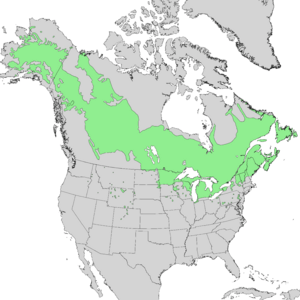Balsam poplar facts for kids
Quick facts for kids Balsam poplar |
|
|---|---|
 |
|
| A stem with young leaves | |
| Scientific classification | |
| Genus: |
Populus
|
| Species: |
balsamifera
|
 |
|
| Natural range | |
| Synonyms | |
|
|
The balsam poplar (scientific name: Populus balsamifera) is a type of tree. People also call it bam, bamtree, or tacamahac poplar. It belongs to the poplar family, Populus. The name Populus comes from a Latin word for "poplar." The name balsamifera means "balsam-bearing" in Latin. This refers to the tree's sweet, sticky sap.
The balsam poplar is the northernmost hardwood tree in North America. It grows across the continent in cool, northern areas. It likes flood plains, which are flat lands next to rivers. These trees grow fast but usually do not live very long. However, some have been found to be as old as 200 years!
This tree is famous for its strong, sweet smell. This scent comes from its sticky, resin-filled buds. Many people say it smells like a balsam fir tree.
What is Balsam Poplar?
The balsam poplar is a hardy and fast-growing tree. It is a common sight in the northern parts of North America. It can grow in many different places. But it grows best where there is plenty of water, like near rivers.
Balsam Poplar Family and Relatives
Sometimes, the black cottonwood (Populus trichocarpa) is thought to be a type of balsam poplar. But they are not very closely related.
There is also a special hybrid tree called balm-of-Gilead (Populus × jackii). This tree is a mix of the balsam poplar and the eastern cottonwood (P. deltoides). It grows where the two parent trees' homes overlap. People sometimes plant balm-of-Gilead as a shade tree. It can also grow wild from these planted trees.
How People and Animals Use Balsam Poplar
The wood of the balsam poplar is light and soft. It is used to make pulp for paper. It is also used in construction. The sticky, sweet-smelling sap from the tree's buds is called balsam. Bees sometimes use this balsam to clean their hives.
Many animals eat the twigs of the balsam poplar. The leaves are also food for caterpillars. These caterpillars later turn into different kinds of moths and butterflies. You can find more about them in the List of Lepidoptera that feed on poplars.

